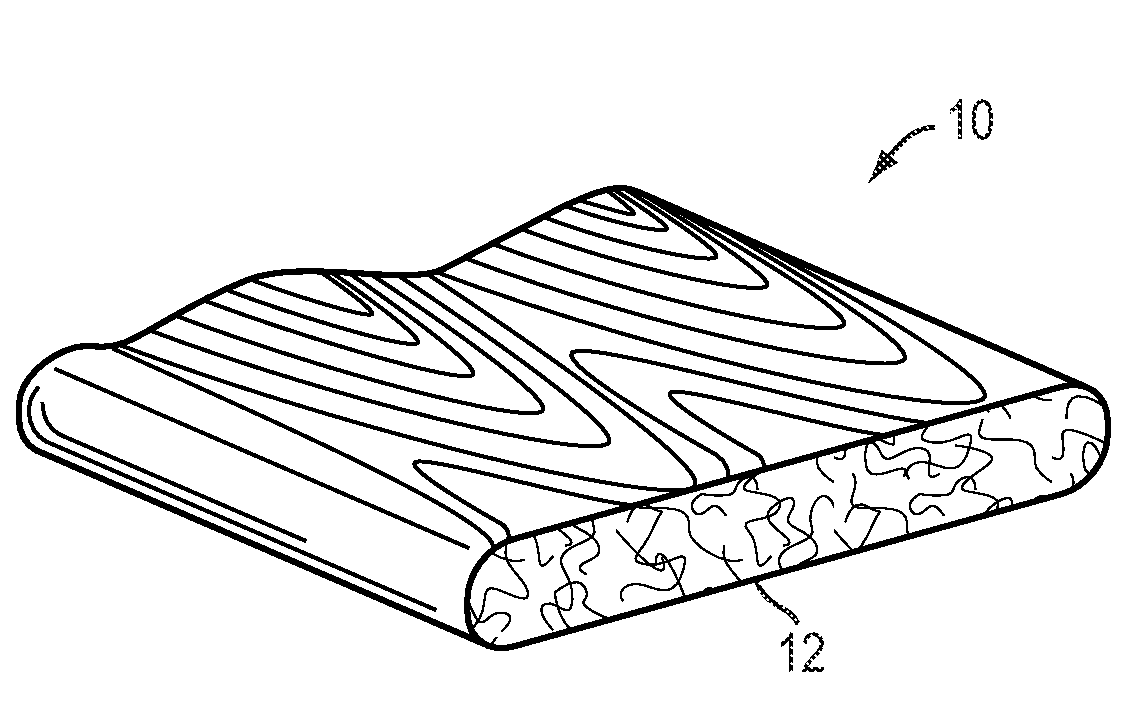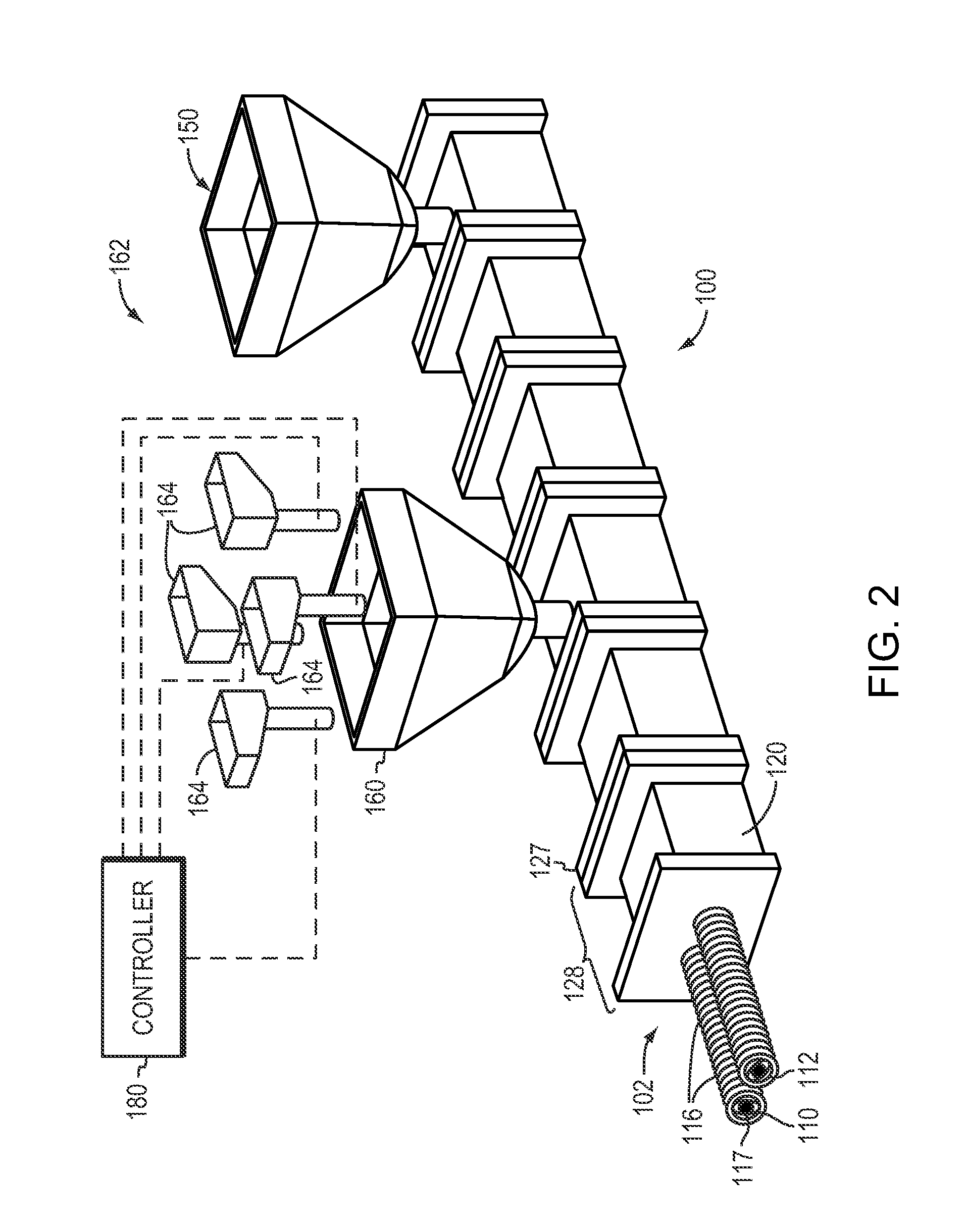Plastic Composites Using Recycled Carpet Waste and Systems and Methods of Recycling Carpet Waste
a technology of carpet waste and plastic composites, which is applied in the field of systems and methods for fabricating wood or natural fiberplastic composite extrusions, can solve the problems of low material cost, low material cost, and inability to meet the requirements of the market, and achieve the effect of reducing the cost of materials
- Summary
- Abstract
- Description
- Claims
- Application Information
AI Technical Summary
Benefits of technology
Problems solved by technology
Method used
Image
Examples
example 1
[0078]Example 1 depicts an exemplary WPC manufactured with 15.7% post-consumer carpet waste. As can be seen, although the total weight of HDPE pellet and wood filler remains consistent with that utilized in Comparative Example 1, the use of recycled carpet waste effectively decreases the percentage of those components within Example 1. The use of recycled carpet waste results in Example 1 failing at 633 lbf, with a displacement at failure of 2.244 inches. The physical mechanism responsible for this decrease in displacement at failure, as compared to the Comparative Example 1, is the subject of further study. Notably, however, the water absorption of Example 1 is considerably lower than that of the Comparative Example 1, as the increased amount of recycled carpet waste effectively decreases the percentage of wood filler within Example 1.
TABLE D-1Example 1FCFC6524CMateriallb.%Main FeedHDPE Pellet246.035.1Regrind (Pulverized)0.00.0Regrind (Flake)0.00.0Repro0.00.0Struktol 1040.00.0Color...
example 2
[0079]Example 2 depicts an exemplary WPC manufactured with 26.9% post-consumer carpet waste. Similar to Example 1, the total weight of HDPE pellet and wood filler remains consistent with that utilized in Comparative Example 1, while the increased use of recycled carpet waste again decreases the percentage of those components within Example 2. The use of recycled carpet waste results in Example 2 failing at 605 lbf, with a displacement at failure of 1.662 inches. Again, the decrease in displacement at failure, as compared to both Comparative Example 1 and Example 1, is the subject of further study, but the decrease appears to be directly linked to the amount of recycled carpet waste present in Example 2. Presumably, a sample containing an even higher percentage of recycled carpet waste would have an even lower displacement at failure. Notably, again, the water absorption of Example 2 is lower than that of both Comparative Example 1 and Example 1. This is consistent with the observati...
example 3
[0098]Example 3 depicts the quantities of compounds required for an exemplary WPC manufactured in accordance with the present invention, with HDPE, 19.8% post-consumer carpet waste, and 1.6% CFA. The anticipated performance characteristics of a product manufactured with this formulation are also depicted. This extruded material should fail at approximately 700 lbf, and at a displacement of about 1.6 inches. Additionally, the specific gravity of the sample is expected to be similar to that of Comparative Example 3.
TABLE D-3Example 3FCFCMateriallb.%Main FeedHDPE pellet / powder184.524.3Regrind (pulverized)61.58.1Regrind (flake)0.0Repro0.0Lubricant38.05.0Color0.0CW 1150.019.8CW 20.0Chemical Foaming Agent12.01.6Side FeedWood filler300.739.6Color0.0CW 10.0CW 20.0Lubricant0.0Chemical Foaming Agent121.6Formulation Weight758.798.4Rate, lb. / hr.Stress, psisg = .802400Displacement, in.1.6MOE, psi470000Load, lbf.700Water Absorption, %
[0099]Table C-4, C-5, and D-4 depicts various examples of extru...
PUM
| Property | Measurement | Unit |
|---|---|---|
| length | aaaaa | aaaaa |
| length | aaaaa | aaaaa |
| length | aaaaa | aaaaa |
Abstract
Description
Claims
Application Information
 Login to View More
Login to View More - R&D
- Intellectual Property
- Life Sciences
- Materials
- Tech Scout
- Unparalleled Data Quality
- Higher Quality Content
- 60% Fewer Hallucinations
Browse by: Latest US Patents, China's latest patents, Technical Efficacy Thesaurus, Application Domain, Technology Topic, Popular Technical Reports.
© 2025 PatSnap. All rights reserved.Legal|Privacy policy|Modern Slavery Act Transparency Statement|Sitemap|About US| Contact US: help@patsnap.com



